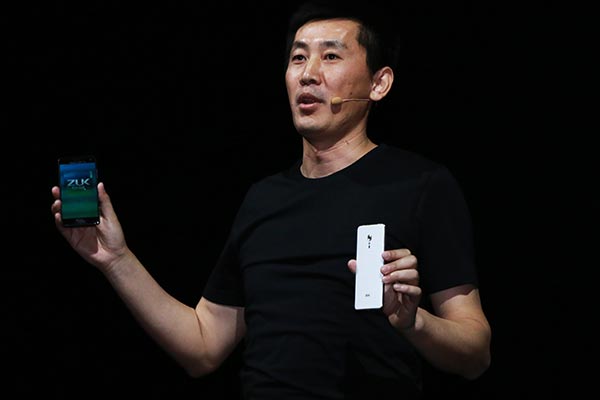 |
|
Chang Cheng, CEO of ZUK, Lenovo's third smartphone brand, unveiled its latest smartphone Z2 Pro on April 21, 2016 to compete in the middle-end market, with a price tag of $416. [Photo provided to chinadaily.com.cn] |
The move makes the world's largest PC maker the latest Chinese company to bank on bricks-and-mortar retailers to spur growth as the country's smartphone market is reaching saturation.
Chen Xudong, the company's senior vice-president in charge of its China mobile business group, said: "This year, we will devote huge resources to establishing Lenovo's image as a quality smartphone vendor, with its focus on marketing and offline retailing."
Chen's remarks were Lenovo's first public announcement of its smartphone strategy in the 2016 fiscal year. But he declined to disclose more details, only saying "we will show the world our teeth with cutting-edge products", indicating the Beijing-based company will be more aggressive.
At a ceremony on Thursday, the company's third smartphone brand ZUK unveiled its latest smartphone Z2 Pro to compete in the middle-end market, with a price tag of 2,699 yuan ($416).
The Z2 Pro has a 5.2-inch screen and is equipped with a snapdragon 820 processor by Qualcomm Inc, a common feature seen in Chinese vendors' flagship smartphones released this year.
Yang Yuanqing, chairman and CEO of Lenovo, said the Z2 Pro will also be available in overseas markets but did not offer a timetable for this.
In February, Lenovo's major local rival Xiaomi Corp announced it will open 200 to 300 retail stores to boost sales.
Lenovo was the world's fourth-largest smartphone vendor in 2015. It shipped 74 million handsets last year, with decline rate of 21 percent, according to the research firm International Data Corp.
But on its home turf, the Chinese company is already dropping out of the competition as local rivals such as Xiaomi and Huawei Technologies Co Ltd leap forward. In the quarter ending Dec 31, it failed to make it into the list of the top five phone vendors in the mainland.
